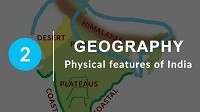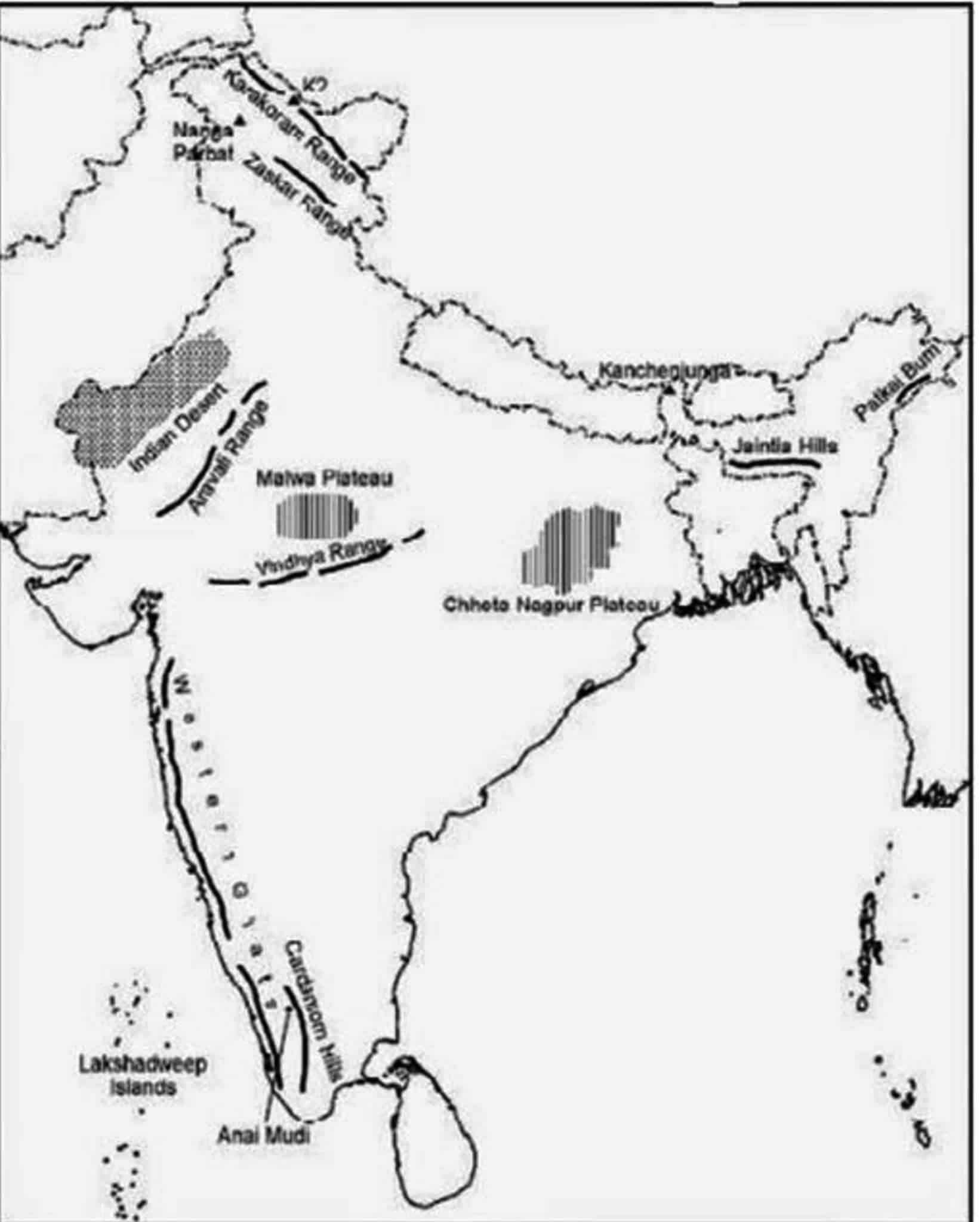
Complete NCERT Book Page wise Solution Class 9th as per Latest CBSE Syllabus
Geography
Chapter 2 Geography Physical Features of India
The following page provides you NCERT book solutions for class 9 social science, social science class 9 notes in pdf are also available in the related links between the texts.
Question 1: Choose the right answer from the four alternatives given below.
a)A landmass bounded by sea on three sides is referred to as
b)Coast
c)Island
d)Peninsula
e)none of the above
Answer : (c) Peninsula
(ii)Mountain ranges in the eastern part of India forming its boundary with Myanmar are collectively called as
a)Himachal
b)Uttarakhand
c)Purvachal
d)none of the above
Answer : c) Purvanchal
(iii)The western coastal strip, south of Goa is referred to as
a)Coromandel
b)Konkan
c)Kannad
d)Northern Circar
Answer :(b) Kannad
(iv)The highest peak in the Eastern Ghats is
a)Anai Mudi
b)Kanchenjunga
c)Mahendragiri
d)Khasi
Answer : (c) Mahendragiri
Question 2:Answer the following questions briefly.
(i).What are tectonic plates?
Answer :(i) The crust (upper part) of the earth has been formed out of seven major and some minor plates. These are called tectonic plates.
A Tectonic plate (also called lithospheric plate) is a massive, irregularly shaped slab of solid rock, generally composed of both continental and oceanic lithosphere. Plate size can vary greatly, from a few hundred to thousands of kilometers across; the Pacific and Antarctic Plates are among the largest. Plate thickness also varies greatly, ranging from less than 15 km for young oceanic lithosphere to about 200 km or more for ancient continental lithosphere.
(ii).Which continents of today were part of the Gondwana land?
Answer : (ii)South America, part of Africa (south Africa including Madagascar), part of Asia (India, Arabia, Malaya), Australia and Antarctica continents were parts of the Gondwana land.
(iii).What is the bhabar?
Answer : (iii)The Bhabar is that narrow belt of the plain which is covered with pebbles and lies along the foothills of the Shiwaliks from the Indus to the Teesta.
(iv).Name the three major divisions of the Himalayas from north to south.
Answer : The 3 major divisions of the Himalayas from North to South are as follows
a)The Great or Inner Himalayas or the Himadri It is a continuous range consisting of the highest
b) Himachal or Lesser Himalayas The range lying to the South of the Himadri is known as Himachal or Lesser
c)Shiwaliks The outermost range of the Himalayas is known as the These are the foothill ranges and represent the southernmost division of the Himalayas.
(v).Which plateau lies between the Aravali and the Vindhyan ranges?
Answer : (v)The Malwa plateau lies between the Aravali and the Vindhya Ranges.
(vi).Name the island group of India having coral origin.
Answer (vi)Lakshadweep Islands is the island group of India having coral origin
Question 3. Distinguish between
(i)Converging and diverging tectonic plates
Answer: (i)
| ConvergingTectonicPlates | Diverging Tectonic Plates |
|
When tectonic plates move towards each other, they are called converging plates. |
When tectonic plates move away from each other, they are called diverging plates. |
| They collide or crumble or one of them slides under the other while moving towards each other. |
They do not collide or crumble while moving away from each other.Diverging plates cause fractures in the |
(ii) Bhangar and Khadar
|
(iii)Western Ghats and Eastern Ghats
|
Question 4. Describe how the Himalayas were formed.
Answer : According to the Theory of Plate Tectonics, the Earth’s crust was initially a single, giant super-continent called Pangea.
(a)The oldest landmass of India (peninsular part) was a part of Gondwana
(b)Gondwana land included India, Australia, South Africa and South America as one single
(c)Convectional currents split the crust into a number of pieces, thereby leading to the drifting of the Indo – Australian plate after being separated from the Gondwana land towards the
(d)The Northward drift resulted in the collision of the plate with the much larger Eurasian
(e)Due to this collision the sedimentary rocks which were accumulated in the geosyncline known as the Tethys, were folded to form the mountain systems of Western Asia and
(f)The Himalayas represent a youthful topography with high peaks, deep valleys and fast following
Question 5. Which are the major physiographic divisions of India? Contrast the relief of the Himalayan region with that of the Peninsular plateau.
Answer : The major physiography divisions of India are :
(i)The Himalayan Mountains
(ii)The Northern Plains
(iii)The Peninsular Plateau
(iv)The Indian Desert
(v)The Coastal Plains
(vi)The Islands
| The Himalayan Region | The Peninsular Plateau |
| Young fold mountains made from the uplift of the strata formed bythe sedimentary rocks. |
Created from igneous and metamorphicrocks after splitting of Gondwanaland. |
| Consists of the loftiest mountains and deep valleys | Consists of broad and shallow valleys, and rounded hills |
| The ranges have I-shapedand U-shaped valleys. | It has horsts, rift valleys and troughs. |
| It is the origin of perennial rivers. | It has rainfed, seasonal rivers. |
| From the point of view of geology, this region forms an unstable zone |
This region forms a stable zone |
Question 6. Give an account of the Northern Plains of India.
Answer : (a) The Himalayan uplift out of the Tethys sea and subsidence of the Northern flank of the peninsular plateau resulted in the formation of a large basin. In course of time, this depression gradually got filled with deposition of sediments from rivers flowing from the mountains In the north and led to formation of the fertile Northern plains.
(b)bIt spreads over an area of 7 lakh sq The plain IS about 2400 km long and 240-230 km broad
(c)It is a densely populated and an Intensively cultivated
(d)With Its adequate water supply and favourable climate, It is agriculturally a very productive part of India
(e)The Northern plains are broadly divided into 3
(f)The Western part of the Northern plans IS called the Punjab plains, formed by the Indus and its
(g)The Ganga plain extends between the Ghaggar and the Teesta rivers, spread over the states of Haryana, Delhi, UP Bihar and West
(h)The Brahmaputra Plain to the East of the Ganga plains lies the Brahmaputra plain covering the areas of Assam and Arunachal Pradesh.
(i)The difference in relief has led the North Indian Plains to be divided into four zones : (i) Bhabhar, (ii) Tarai, (iii) Bangar and (iv)
Question 7. Write short notes on the following.
(i)The Indian Desert
Answer : The Indian desert lies towards the Western margin of the Aravalli hills. It is an undulating sandy plain covered with sand dunes.
This region receives very low rainfall, below 150 mm per year. It has arid climate with low vegetation cover.
Streams appear during the rainy season. Soon they disappear into the sand as they do not have enough water to reach the sea.
Luni is the only large river in this region.
Barchan (Crescent shaped dunes) cover the larger areas but longitudinal dunes become more prominent near the Indo – Pakistan border.
The Indian desert is popularly known as the Thar desert.
(ii)The Central Highlands
Answer :(ii) The Peninsular plateau consists of two broad divisions, namely the central highlands and the Deccan plateau.
The part of the Peninsular plateau lying to the north of the Narmada river covering a major area of the Malwa plateau is known as the Central Highlands.
They are bound by the Vindhya Range from the south and by the Aravalli hills from the north-west.
The further westward extension gradually merges with the sandy and rocky desert of Rajasthan.
The flow of the rivers draining this region, namely the Chambal, the Sind, the Betwe and Ken is from south-west to north-east.
The central highlands are wider in the west but narrower in the east.
The eastward extensions of their plateau are locally known as ‘Bundelkhand’ and Baghelkhand.
The Chhotanagpur plateau marks the further eastward extension drained by the Damodar river.
(iii)The Island groups of India
Answer : India has two groups of islands namely the Lakshadweep group and the Andaman and Nicobar group.
(a)The Lakshadweep Islands Group lie close to the Malabar coast of These islands are composed of small coral islands.
Earlier, they were known as Laccadive, Minicoy and Amindive. In 1973, these were renamed as the Lakshadweep.
They cover a small area of 32 sq km.
Kavaratti Island is the administrative headquarters of Lakshadweep. This island group has a great diversity of flora and fauna.
The Pitti Island, which is uninhabited, has a bird sanctuary.
(b)Andaman and Nicobar Islands
The elongated chain of islands located in the Bay of Bengal extending from north to south are the Andaman and Nicobar Islands.
They are bigger in size and more numerous and scattered than the Lakshadweep Islands. The entire group of islands is divided into two broad categories, the Andaman in the north and Nicobar in the south.
It is believed that these islands are an elevated portion of the submarine mountains. These islands are of great – strategic importance for the country.
They have great diversity of flora and fauna.
These islands lie close to the equator experience equatorial climate and have thick forest cover.
MAP SKILLS
On an outline map of India show the following.
(i)Mountain and hill ranges – the Karakoram, the Zaskar, the Patkai Bum, the Jaintia, the Vindhya range, the Aravali, and the Cardamom
(ii)Peaks – K2, Kanchenjunga, Nanga Parbat and the Anai
(iii)Plateaus, Chotanagpur and Malwa
(iv)The Indian Desert, Western Ghats, Lakshadweep Islands
Answer
